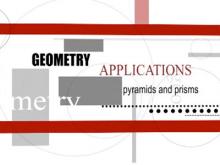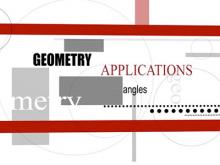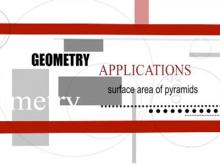Content Showcase: Video Library
|
Media4Math's Video Library is a collection of videos on key topics in pre-algebra and algebra. Each video includes several worked-out examples that clearly explain the key concept. All videos include real-world applications of math.This is a growing collection of resources, so keep coming back!(Want to learn more about our subscription packages? Click here.)
|
| Thumbnail Image | Description | Curriculum Topics | |
|---|---|---|---|
Closed Captioned Video: Geometry Applications--Antiprisms |

|
Closed Captioned Video: Geometry Applications--Antiprisms
In this video students learn the basics of antiprisms, in the context of New York’s Freedom Tower, which has an antiprism design. They learn the properties of antiprisms, with the focus on those with a square base. |
Rectangular Prisms |
Closed Captioned Video: Geometry Applications--Pyramid Volume |

|
Closed Captioned Video: Geometry Applications--Pyramid Volume
In this video, students see a derivation of the formula for the volume of a pyramid. This involves a hands-on activity using unit cubes, along with analysis, and a detailed algebraic derivation. |
Pyramids |
Closed Captioned Video: Geometry Applications--Rectangular Prisms |

|
Closed Captioned Video: Geometry Applications--Rectangular Prisms
In this video students learn the basics of rectangular prisms, in the context of a New York residential tower: 432 Park Avenue. |
Rectangular Prisms |
Closed Captioned Video: Geometry Applications--Triangular Prisms |

|
Closed Captioned Video: Geometry Applications--Triangular Prisms
In this video students study a real-world application of triangular prisms: The Flat Iron Building in New York City. This building is an ideal example of a real-world prism and also provides a tie-in to right triangle geometry. |
Triangular Prisms |
Closed Captioned Video: Geometry Applications--What Are Prisms? |

|
Closed Captioned Video: Geometry Applications--What Are Prisms?
In this video students learn the basics of prisms and anti prisms. They learn the properties of triangular prisms, rectangular prisms, triangular antiprisms, and rectangular antiprisms. |
Rectangular Prisms and Triangular Prisms |
Closed Captioned Video: Geometry Applications: 3D Geometry |

|
Closed Captioned Video: Geometry Applications: 3D Geometry
In this program we explore the properties of three-dimensional figures. We do this in the context of two real-world applications. In the first, we look at the three-dimensional structure of Mayan pyramids. |
3-Dimensional Figures |
Closed Captioned Video: Geometry Applications: 3D Geometry, 1 |

|
Closed Captioned Video: Geometry Applications: 3D Geometry, Segment 1: Introduction.
We visit ancient Greece to learn about the Platonic Solids. This provides an introduction to the more general topic of three-dimensional figures. |
3-Dimensional Figures |
Closed Captioned Video: Geometry Applications: 3D Geometry, 2 |

|
Closed Captioned Video: Geometry Applications: 3D Geometry, Segment 2: Pyramids
Rectangular Prisms. Mayan pyramids are essentially stacks of rectangular prisms. The volume of each successive level is a percentage decrease of its lower neighbor. This introduces the notion of a geometric sequence and series, including an infinite series. |
3-Dimensional Figures and Pyramids |
Closed Captioned Video: Geometry Applications: 3D Geometry, 3 |

|
Closed Captioned Video: Geometry Applications: 3D Geometry, Segment 3: Cylinders
The Shanghai Tower in China is a stack of cylindrical shapes, where each successive layer is a percentage decrease of its lower neighbor. As with the previous section, this introduces the notion of a geometric sequence and series. |
3-Dimensional Figures and Cylinders |
Closed Captioned Video: Geometry Applications: Angles and Planes |

|
Closed Captioned Video: Geometry Applications: Angles and Planes
In this program we explore the properties of angles and planes. We do this in the context of two real-world applications. In the first, we explore Japan's Himeji Castle and in the process learn about different types of angles and how they're used in a defensive fortification. |
Applications of Angles and Planes |
Closed Captioned Video: Geometry Applications: Angles and Planes, 1 |

|
Closed Captioned Video: Geometry Applications: Angles and Planes, Segment 1: Introduction
The observatory in Arecibo, Puerto Rico provides astronomers insights into the structure of our solar system. Geometrically, the solar system relies on the plane known as the ecliptic. |
Applications of Angles and Planes |
Closed Captioned Video: Geometry Applications: Angles and Planes, 2 |

|
Closed Captioned Video: Geometry Applications: Angles and Planes, Segment 2: Angles
Himeji castle in Japan is a marvel of architecture and a startling example of geometry and military science. |
Applications of Angles and Planes |
Closed Captioned Video: Geometry Applications: Angles and Planes, 3 |

|
Closed Captioned Video: Geometry Applications: Angles and Planes, Segment 3: Planes
In the Canadian Rockies, the Burgess Shale fossils provide a window to prehistoric Earth. Fossil layers are folded into sedimentary rocks. And sedimentary rocks are examples of parallel planes. This segment uses the properties of planes to analyze fossils. |
Applications of Angles and Planes |
Closed Captioned Video: Geometry Applications: Area and Volume |

|
Closed Captioned Video: Geometry Applications: Area and Volume
In this program we look at applications of area and volume. We do this in the context of three real-world applications. In the first, we look at the sinking of the Titanic in the context of volume and density. |
Applications of Surface Area and Volume, Surface Area and Volume |
Closed Captioned Video: Geometry Applications: Area and Volume, 1 |

|
Closed Captioned Video: Geometry Applications: Area and Volume, Segment 1: Volume and Density.
The sinking of the Titanic provides an opportunity to explore volume, density, and buoyancy. Students construct a mathematical model of the Titanic to determine why it sank and what could have been done to prevent it from sinking. |
Applications of Surface Area and Volume, Surface Area and Volume |
Closed Captioned Video: Geometry Applications: Area and Volume, 2 |

|
Closed Captioned Video: Geometry Applications: Area and Volume, Segment 2: Surface Area.
The glass-paneled pyramid at the Louvre Museum in Paris is a tessellation of rhombus-shaped glass panels. Students create a model of the pyramid to calculate the number of panels used to cover the surface area of the pyramid. |
Applications of Surface Area and Volume, Surface Area and Volume |
Closed Captioned Video: Geometry Applications: Area and Volume, 3 |

|
Closed Captioned Video: Geometry Applications: Area and Volume, Segment 3: Ratio of Surface Area to Volume.
The Citibank Tower in New York City presents some unique design challenges. In addition it has to cope with a problem that all tall structure have to deal with: heat loss. |
Applications of Surface Area and Volume, Surface Area and Volume |
Closed Captioned Video: Geometry Applications: Circles |

|
Closed Captioned Video: Geometry Applications: Circles
In this program we explore the properties of circles. We do this in the context of two real-world applications. In the first, we look at the design of the Roman Coliseum and explore how circular shapes could have been used to design this elliptical structure. |
Applications of Circles and Definition of a Circle |
Closed Captioned Video: Geometry Applications: Circles, 1 |

|
Closed Captioned Video: Geometry Applications: Circles, Segment 1: The Basics of Circles.
We visit Chaco Canyon in New Mexico to explore the circular kivas and in the process discover how circular buildings have been used to study the heavens. |
Applications of Circles and Definition of a Circle |
Closed Captioned Video: Geometry Applications: Circles, 2 |

|
Closed Captioned Video: Geometry Applications: Circles, Segment 2: Circles and Arcs.
The Roman Coliseum is a large elliptical structure. Yet, the Romans likely used circular arcs to build it. This segment explores the properties of circles and shows how arcs can be used to create elliptical shapes. |
Applications of Circles and Definition of a Circle |